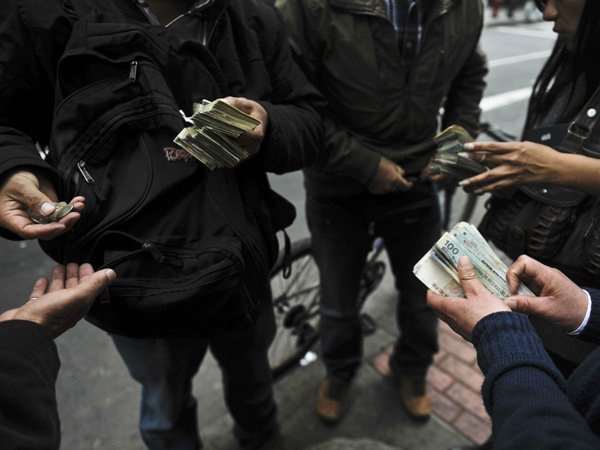Fake dollars cost Peru plenty

Street money changers exchange US dollar notes in Lima on September 6, 2012. The street money changers in Peru are experts in introducing counterfeit US dollar notes in the local and international markets. AFP PHOTO/ERNESTO BENAVIDES
LIMA – Peru, one of Latin America’s fast-growing economies and a hub of the global cocaine trade, has emerged as a producer of counterfeit US dollars being used both abroad and at home.
Counterfeiting has grown large and fast enough that US authorities call Peru one of Latin America’s worst offenders when it comes to cranking out fake US currency.
In Lima, many people traditionally change their currency, soles, to dollars on the street to get a slightly better rate than in banks, without the wait.
And that arrangement has opened a big door to counterfeiters.
“People moving the counterfeit greenbacks set up shop around the city. And they always have getaway cars close by when they make a big transaction or when we identify them,” said Antolin Vilca, a currency trader who has worked for two decades on the street in Lima’s financial district.
Article continues after this advertisementCounterfeiters show up as street dollar traders finish up their days, hoping to swap fake larger US notes for lots of real smaller-denomination dollars.
Article continues after this advertisement“They start turning up at the end of the workday,” likely hoping that in their eagerness to get home, honest traders will slip up and take the fake bait, Vilca said.
So far this year, police in Peru have seized 8.3 million counterfeit US bills of various denominations, National Anti-Fraud Unit chief Colonel Segundo Portocarrero told AFP.
And consumers are taking a growing hit from the counterfeit bills in retail transactions and even at their homes, when selling their personal items.
Filomeno Olivera, a trader who works near a market area in the San Miguel neighborhood, said another big strategy by counterfeiters is to answer newspaper ads for people selling cars, computers or other big ticket items.
“Let’s say you put an ad in the paper to sell a computer for $500,” Olivera explained. “Somebody shows up at your house, nicely dressed and quite friendly. And they buy your item from you on the spot, no haggling – and of course in fake dollars.”
And Peru’s new counterfeit product is making its presence felt in neighboring Ecuador, where the US dollar is the official currency, as well as in Bolivia, Mexico and the United States itself, Portocarrero said.
Some experts estimate that more than 10 percent of counterfeit dollars in circulation in the United States are made in Peru.
Police say that local counterfeiters have links to international organized crime, especially from Mexico and Colombia.
Portocarrero said Peruvian authorities were “working on” cooperating with the United States to tackle the problem.
One of the renowned local “masters” of forgery is Peru’s Joel Quispe Rodriguez.
Though his band of counterfeiters was broken up last year, police say he may still be running his organization from behind bars as he awaits trial.
Dollar traders on the streets complain that criminals moving counterfeit bills often get picked up and taken to a police station for booking, only to appear back on the street within hours.